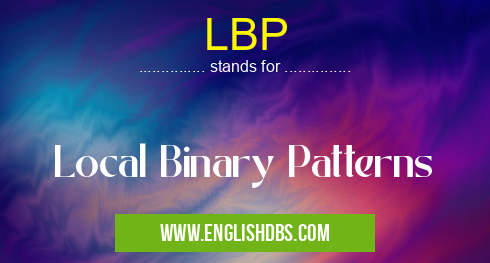What does LBP mean in UNCLASSIFIED
Local Binary Patterns (LBP) is an important tool in machine learning workshops that are used to compare and analyze patterns from images. It was developed in the 1990s mainly for texture analysis, but it has been used widely for face recognition and other image related tasks. LBP works by comparing local texture properties of different regions of an image or video frame using a series of binary codes. This technique is extremely useful as it can identify different patterns even when there is a slight variation in the texture of the object being observed. LBP has become one of the most widely used methods for feature extraction and pattern recognition due to its simplicity, effectiveness, speed, and flexibility.

LBP meaning in Unclassified in Miscellaneous
LBP mostly used in an acronym Unclassified in Category Miscellaneous that means Local Binary Patterns
Shorthand: LBP,
Full Form: Local Binary Patterns
For more information of "Local Binary Patterns", see the section below.
Essential Questions and Answers on Local Binary Patterns in "MISCELLANEOUS»UNFILED"
What is LBP?
Local Binary Patterns (LBP) is a type of visual descriptor used for classification in computer vision. It is used to extract features from images by comparing each pixel to its surrounding pixels, and encoding the result into a binary number. This technique provides a low computational cost approach and has proven to be robust in numerous applications.
How does LBP work?
Local Binary Patterns (LBP) works by calculating a binary pattern for every pixel in an image. The value of each pixel is compared to its surrounding pixels and the result is encoded as either 0 or 1 depending on how similar they are. The results are then used as features allowing for classification of the image.
What are some applications of LBP?
Local Binary Patterns (LBP) has been utilized in many different applications such as facial recognition, texture analysis, medical imaging, and object detection just to name a few.
How does LBP compare to other feature extraction techniques?
Local Binary Patterns (LBP) compare well against traditional feature extraction techniques such as Histogram of Gradients (HoG), Scale Invariant Feature Transform (SIFT), or Speeded Up Robust Features (SURF) as it provides fewer dimensions while still maintaining accuracy and being less computationally expensive than other methods.
What types of images can be processed using Local Binary Patterns?
Local Binary Patterns (LBP) can be used with any type of image whether it be grayscale or color since it only relies on the relative intensity values between neighboring pixels.
How fast is Local Binary Pattern processing?
Local Binary Patterns can generally process an image relatively quickly due to its low computational cost as compared to other feature extraction techniques. Depending on the complexity of the image being analyzed, processing times will vary but usually take less time than more computationally expensive methods such as SIFT or SURF.
How much memory does LBP require?
The amount of memory needed for Local Binary Pattern processing depends on the size and complexity of the image being processed, however typically the amount required tends to be quite small which makes it well suited for mobile and embedded systems that may have limited resources available.
Is there any pre-processing necessary before using LBP?
No pre-processing is necessary before utilizing Local Binary Pattern analysis, however depending on user preferences some post-processing may be necessary if greater accuracy or improved performance is desired from the extracted features.
Does Local Binary Pattern processing require calibration?
No calibration steps are required when utilizing local binary pattern processing, however if higher precision results are desired then certain parameters may need to be adjusted such as varying scales or rotation angles depending on user preferences.
Final Words:
Local Binary Patterns (LBP) have become one of the most popular methods for feature extraction and pattern recognition due to their simplicity, effectiveness, speed, and flexibility. They work by taking small patches around each pixel in an image and computing binary sequences which characterize each patch based on their relative values at each pixel's center compared to its neighbors. These binary sequences are then compared against each other to find any similarities between them which can be used for various tasks such as object detection or facial recognition.
